Virginia Lipscomb Curtain Club Endowed Scholarship
Years have gone by since Virginia was accepted into the Curtain Club at The University of Texas in 1943. It fulfilled her dream to be a member of the famous dramatic organization, though now the Curtain Club is barely remembered. By giving this endowment, Virginia hopes that the student recipients will become aware of the people that made up the Curtain Club and dedicated themselves to pursuing theater careers and living with a dramatic imagination.

The Curtain Club influenced Virginia’s life by teaching her to know good theater when she saw it, to seek it all over the world, to recognize it in the words she reads, the music she hears, and to recognize the comedy and drama lurking in everyday living. In other words, to always be blessed with the dramatic imagination.
Curtain Club
During its heyday, it was one of the most popular student organizations on campus. Countless Texas politicians, entertainers, and public figures joined the club when they were UT students.
The Curtain Club had a profound effect upon the early years of the Department of Drama, and many say it is due to the Curtain Club’s influence on the campus community that the Department of Drama was created.
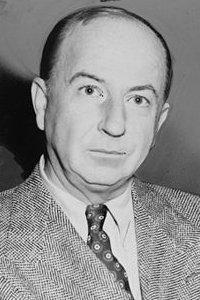
Stark Young, UT professor and Club Advisor
The Beginnings
In the fall of 1908, several young men approached Stark Young, an English professor at UT, with the idea of forming a club whose purpose would be “to promote dramatic activity and the study of Shakespeare.” Young agreed to sponsor the extracurricular organization and direct its productions. The name they chose was taken from a London theater which flourished in Shakespeare’s day, and the Curtain Club was born.
On March 2, 1909, the Curtain Club produced Ben Jonson’s The Silent Woman with an all-male cast. Judging from contemporary articles in The Cactus and The Alcalde, the play was deemed a rousing success. In 1911, Moliere’s The Miser played before a packed auditorium and later toured Texas.
Regnard’s The Sole Heir was presented in 1912. Its script was written in French, and Young made the first American translation, which was sent to university dramatic and literary reviews throughout the country. The same year, The Drama, a national theater magazine, hailed the Curtain Club as the leading dramatic club of the South. The plays which the organization produced at UT were so popular that the troupe was invited again to tour statewide.
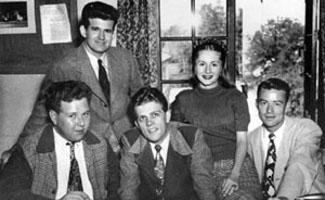
In 1916, women were finally admitted into the club. At that time, the students built all their own scenery and usually borrowed props and costumes. Performances were first held in the University Auditorium until that building was condemned. The Scottish Rite Cathedral, the men’s gym, the Labor Temple, Saengerrunde Hall, and even a tent were to house Curtain Club plays for the next decade.
Young left UT in 1915 to teach at Amherst College, and later to become a well-known theatre critic for the New York Times, New Republic, and Theatre Arts Magazine. The Curtain Club had many other able directors in the years following Young’s departure from UT, including Howard Mumford Jones, Katherine Wheatley, and Ernest Hardin. Hardin not only directed the plays but also designed and executed the sets.
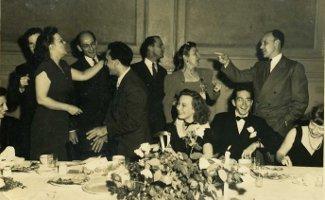
After a slight decline due to World War I, the club became more active and better organized. In 1920, Giacose’s Falling Leaves was produced, and for the first time, costumes, stage setting, play adaptation, and original play writing were emphasized. Interest in the club increased throughout the campus, and in 1922, other departments, besides the English Department, began collaborating with the productions. In 1925, an official constitution was drawn up and a Board of Governors was chosen.
By 1932, membership was no longer restricted to students interested in acting, but was opened to anyone involved in a broader range of theatrical activities, including stage managing, costuming, scenic design, lighting, etc. With the opening of Hogg Auditorium in 1933, the Curtain Club entered a new venue and a new era of sophistication.
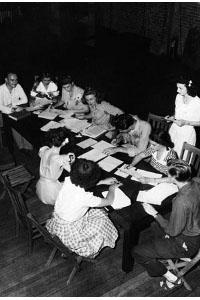
The Golden Years
James H. Parke, another English professor, became Curtain Club director and brought the club to its zenith during the late 30s and throughout the 40s. He directed some lavish productions at Hogg Auditorium which became theatrical springboards for some of the more talented UT students
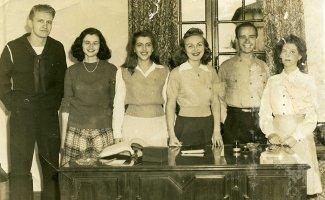
Noel Coward’s Hay Fever inaugurated Hogg Auditorium with a cast that included Bess Harris Jones, Elaine Anderson (later Mrs. John Steinbeck), and Creekmore Fath. Walter Cronkite made his Curtain Club debut in The Ninth Guest (1935). A young history major named Eli Wallach starred in Liliom (1936) with Wheeler Lyon Sucke, Jane Weinert Blumberg, Jack Sucke, Dick Waite, and John B. Connally. Connally, a future governor of Texas, also appeared in The College Widow (1938), a musical. The College Widow’s large cast included Don Jackson, Jerry Wilke English, Pat O’Keefe, Bob McCutchin, William “Deacon” Crain, Clint Anderson, and Mel Pape.
The Curtain Club continued to grow simultaneously in size and reputation, eventually becoming the leading organization of its kind in the Southwest.
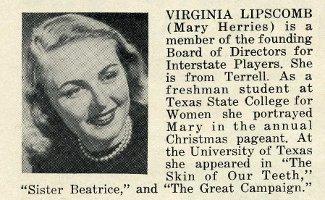
Parke was appointed the first chairman of the Department of Drama in 1938, and he collaborated with the Curtain Club to present the fledgling department’s first productions. Marco Millions (1938), a Eugene O’Neill play, featured several significant speaking roles. Parke’s principal actors included Brooks West, who would later tour with Lunt and Fontaine and Katherine Cornell (and marry his TV co-star, Eve Arden); Zachary Scott, a decade before his fame as a film actor; Allen Ludden, later host of the popular “Password” TV game show; and Idanell Brill (now Mrs. John Connally).
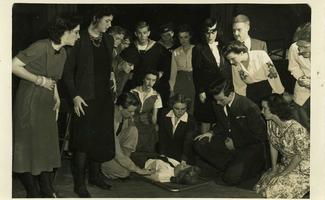
As the Drama Department’s faculty grew, new directors and teachers lent their talents to the Curtain Club. Gordon Minter, Dorothy McLaughlin, and Lawrence Carra influenced the student productions, as did James Moll, who first appeared in 1941 before going off to war. His wife, June Moll, taught on the faculty from 1942-44 and directed several Curtain Club plays in later years. Margo Jones, who read plays by her protégé Tennessee Williams to her UT students, taught and directed during 1942-43.
In 1942, the U.S. Army approached UT with a request for help with entertainment for the troupes. The Curtain Club was notified, and the Cabaret Revue was born. Comprised primarily of female Curtain Clubbers, the revue toured Texas hospitals and Army camps from Corpus Christi and Palacios to Gainesville. The show featured attractive co-eds singing, dancing, and performing skits. The women traveled on weekends, by bus, with their chaperons. Rules were very strict: no beer, no fraternizing with the men.
Hardin sang in the Cabaret Revue and remembered the weekend tours. “We would do entre-acts, singing, and light fare. The boys loved it.”
Most of the male professors, as well as the young college men, had left the UT campus for the war. Virginia Lipscomb Houston (BFA ’45) remembered performing in an all-female show in 1944.
There were no boys around, so we tried to present plays with as many girls as possible,” Houston said. “Gordon Minter directed Nine Girls for the summer Curtain Club production, and I remember what fun we had doing that show.”
By the end of World War II, the Department of Drama and the Curtain Club had officially separated. The club began to work independently, although crossover between Drama faculty and students continued for several years.
The Final Curtain
The troupe continued to attract a variety of talented students from the late 40’s throughout the 1950s. Tom Jones and Harvey Schmidt (who later created The Fantasticks) first met in the Curtain Club.
“He (Jones) was club president, and I wasn’t even studying drama, I was enrolled in the art department,” Schmidt said. “I got into the club not because of my acting, but because I played the piano.”
Schmidt and Jones’ first artistic collaboration was the creation of Hipsy-Boo (1950), a review of American pop music, which Charles (Word) Baker directed for the club. (Baker later directed The Fantasticks off-Broadway.) Fellow Curtain Clubbers who graduated to acting fame included Jayne Mansfield, Rip Torn, Kathryn Grandstaff (later Mrs. Bing Crosby), Pat Hingle, Fess Parker, and Barbara Barrie.
In 1959, the club celebrated its 50th anniversary by staging Teahouse of the August Moon, directed by Mouzon Law. But the demise of the Curtain Club was drawing near.
MLB, the old Modern Language Building, next door to Hogg Auditorium, was home and a haven to Curtain Clubbers and drama majors. The basement housed the shop where the scenery was constructed. The Curtain Club office occupied a cubbyhole on the balcony. The costumes were stored in a small room next to the Experimental Theatre, a classroom with a stage where Drama Lab was held every Friday afternoon. MLB had a long flight of concrete steps at its entrance, always draped with drama students of various shapes and sizes.
In 1959, MLB burned down. The loss of the building heralded the beginning of the end for the Curtain Club. Gradually the organization lost its importance and identity, and finally faded away in 1963. To the Curtain Club members, however, its memory remains vivid.
Special thanks to Coleen Hardin, W. H. “Deacon” Crain, Michael Barnes, and, especially, Virginia Houston, for their contributions to this article, which first appeared in ENCORE, the Department’s alumni magazine, in October 1997. Additional material was written by Dan Boehl.
How to Give
Learn more at giving.utexas.edu
Search Endowments
Look for inspiring stories
